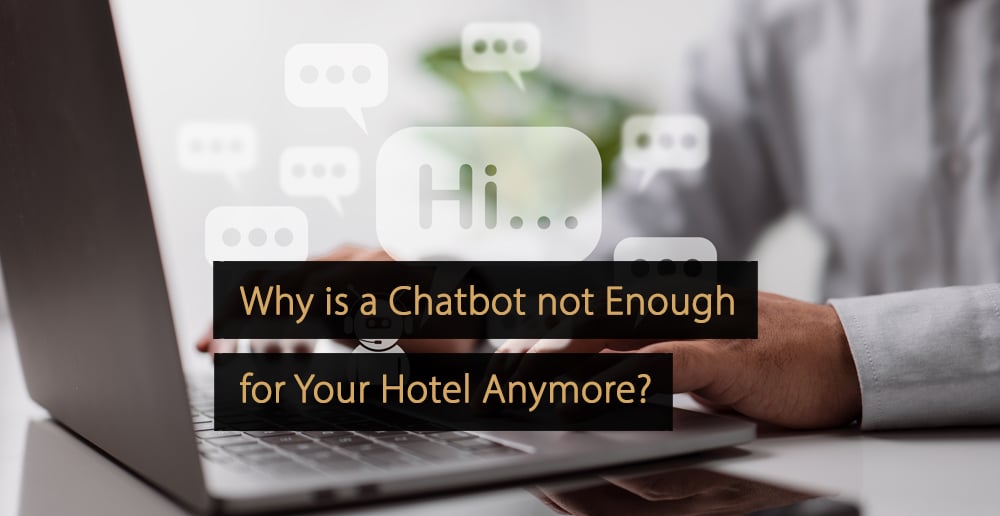Quando os chatbots apareceram pela primeira vez, eles logo se tornaram parte de muitos setores, e a hotelaria não foi exceção. Eles se tornaram uma ótima ferramenta para ajudar os funcionários dos hotéis a lidar com a alta carga de trabalho e as perguntas repetitivas às quais devem responder diariamente. Fornecer aos hóspedes respostas rápidas e instantâneas de forma rápida, em vez de deixá-los esperando 24 horas. E durante alguns anos, isso foi suficiente para criar uma ótima experiência para os hóspedes. No entanto, a situação mudou.
As expectativas dos hóspedes são muito mais complicadas do que há alguns anos
A experiência dos hóspedes vai ainda mais longe hoje e as expectativas dos hóspedes são muito mais complicadas do que há alguns anos. Agora não se trata apenas de responder rapidamente às dúvidas dos hóspedes, mas também de personalização e relacionamento.
Eles querem se sentir ouvidos, vistos e cuidados. Um chatbot é um excelente começo para agilizar suas operações. Ainda assim, não basta potenciar os resultados do seu negócio de alojamento, aumentar a satisfação dos hóspedes e fazer com que os seus hóspedes regressem ao seu hotel.
Por que isso está acontecendo e como você pode aproveitar ao máximo um chatbot e ainda prestar atenção nas demais áreas? Aqui estão alguns pontos que você deve ter em mente.
Chatbots reagem à iniciativa dos convidados
Um chatbot é uma ferramenta reativa. Reage a uma mensagem inicial; responde ao que os outros estão perguntando. Se os convidados fizerem uma pergunta, o chatbot responderá.
Com isso, as operações do hotel ficam mais eficientes e o esforço do cliente é menor, mas você não agrega valor à jornada dele. Em outras palavras, você não está assumindo o controle, apenas reagindo e respondendo ao que eles perguntam.
Os chatbots são ótimos para responder aos visitantes quando sua equipe está ocupada. Eles ajudam você a melhorar a experiência do hóspede e facilitam a vida dos funcionários do hotel.
No entanto, ajudaria se você fosse mais longe. Para potencializar seus resultados, o segredo é focar em toda a jornada do hóspede. Isto é o que o ajudará a construir uma excelente experiência para o hóspede.
Numa pesquisa realizada pela Deloitte, 75% de viajantes disseram que voltariam ao hotel com mais frequência se tivessem uma ótima experiência. Isso significa que um atendimento rápido é bom, mas também cuidar dos hóspedes em todas as etapas da viagem: desde a reserva até o pós-estadia.
Suponha que você queira ser único e se destacar de outras empresas de hospedagem. Nesse caso, você deve proporcionar aos seus convidados uma experiência inesquecível, e usar um chatbot é apenas uma das várias peças do quebra-cabeça.
Por que analisar toda a jornada do hóspede?
A questão que importa é: como personalizar cada etapa da jornada do hóspede? E quais ferramentas podem ajudá-lo com isso?
Existem muitos exemplos de como você pode personalizar a comunicação com os hóspedes, mas resumindo, você deve enviar a mensagem certa ao hóspede certo, na hora certa. E para isso, você precisa das ferramentas certas para complementar o chatbot.
1. Reúna e organize os dados dos hóspedes para saber quem são eles
Os hóspedes têm necessidades e objetivos diferentes em sua estadia, então você precisa de uma ferramenta para coletar e organizar dados confiáveis dos hóspedes em diversas plataformas, como o sistema PMS, F&B e OTAs. Ao fazer isso, você pode ter perfis reais de hóspedes para se basear e conhecer seus convidados.
2. Envie ofertas personalizadas
59% de clientes afirmam que receber conteúdo personalizado impacta significativamente suas decisões de compra. Depois de saber quem são seus convidados, você pode personalizar as mensagens que envia a eles em vez de usar um "um tamanho serve para todos" abordagem.
Ao enviar ofertas relevantes ao hóspede certo, você aumenta suas oportunidades de upsell e, ao mesmo tempo, mostra aos hóspedes que se preocupa com eles e deseja que tenham o melhor durante a estadia.
3. Habilite a comunicação bidirecional
Não se trata de enviar um e-mail ou mensagem que nunca terá resposta ou uma resposta que leva dias; trata-se de enviar e receber mensagens quase da mesma forma que você envia mensagens de texto para amigos.
Isso vem do lado do hoteleiro e do hóspede; se você enviar uma mensagem e iniciar uma conversa, você cria uma conexão e interage com os convidados. Uma excelente maneira é alcançar os hóspedes através de vários canais de comunicação (como WhatsApp, SMS, etc.) em vez de simplesmente e-mail. Isso provou ter taxas de conversão 8 vezes maiores.
4. Faça o hóspede se sentir no controle
Permita que os hóspedes tenham acesso total a todos os detalhes da sua reserva e eventos no hotel em todos os momentos. Estas não devem ser todas as informações relativas à reserva, mas também para serviços e informações adicionais ou qualquer outro acesso relevante de que necessitem. Dessa forma, eles se sentem seguros e no controle.
Uma maneira de fazer isso é com o aplicativo Guest Webb do Bookboost, onde os hóspedes podem acessar todas as informações de que precisam sem baixar ou instalar nada.
De Reativo a Proativo – a Chave para uma Jornada de Hóspede de Sucesso
Usar um chatbot permite que você garanta que suas operações de rotina ocorram sem problemas e reajam com eficiência ao que os hóspedes desejam saber.
Porém, ao complementá-lo com outras ferramentas que personalizam ainda mais a experiência dos hóspedes, você pode ter uma abordagem holística, cuidar de toda a jornada do hóspede e fazer com que ele se sinta especial. Você aumenta a satisfação, a fidelidade e as oportunidades de receita dos hóspedes, fazendo com que eles se sintam ouvidos e vistos.
Agora é tudo uma questão de dar os passos certos. Você tem as ferramentas certas para fazer isso acontecer?
Guia gratuito: Como personalizar a jornada do convidado para os convidados de 2023
Neste guia, “Como personalizar a jornada dos hóspedes de 2023”, você descobrirá a importância de ter uma jornada de hóspede, como ela é e como você pode personalizá-la de acordo com as tendências que norteiam o comportamento dos hóspedes de 2023. Você também encontrará recomendações sobre o desenvolvimento de cada etapa da jornada.
Clique aqui para baixar o guia “Como personalizar a jornada dos hóspedes de 2023”.
Mais dicas para expandir seus negócios
Revfine.com é a plataforma de conhecimento líder para a indústria de hospitalidade e viagens. Profissionais usam nossos insights, estratégias e dicas práticas para se inspirar, otimizar receita, inovar processos e melhorar a experiência do cliente.Explore conselhos de especialistas sobre gestão, marketing, revenue management, operações, software e tecnologia em nosso dedicado Hotel, Hospitalidade, e Viagem de Turismo categorias.








Leave A Comment